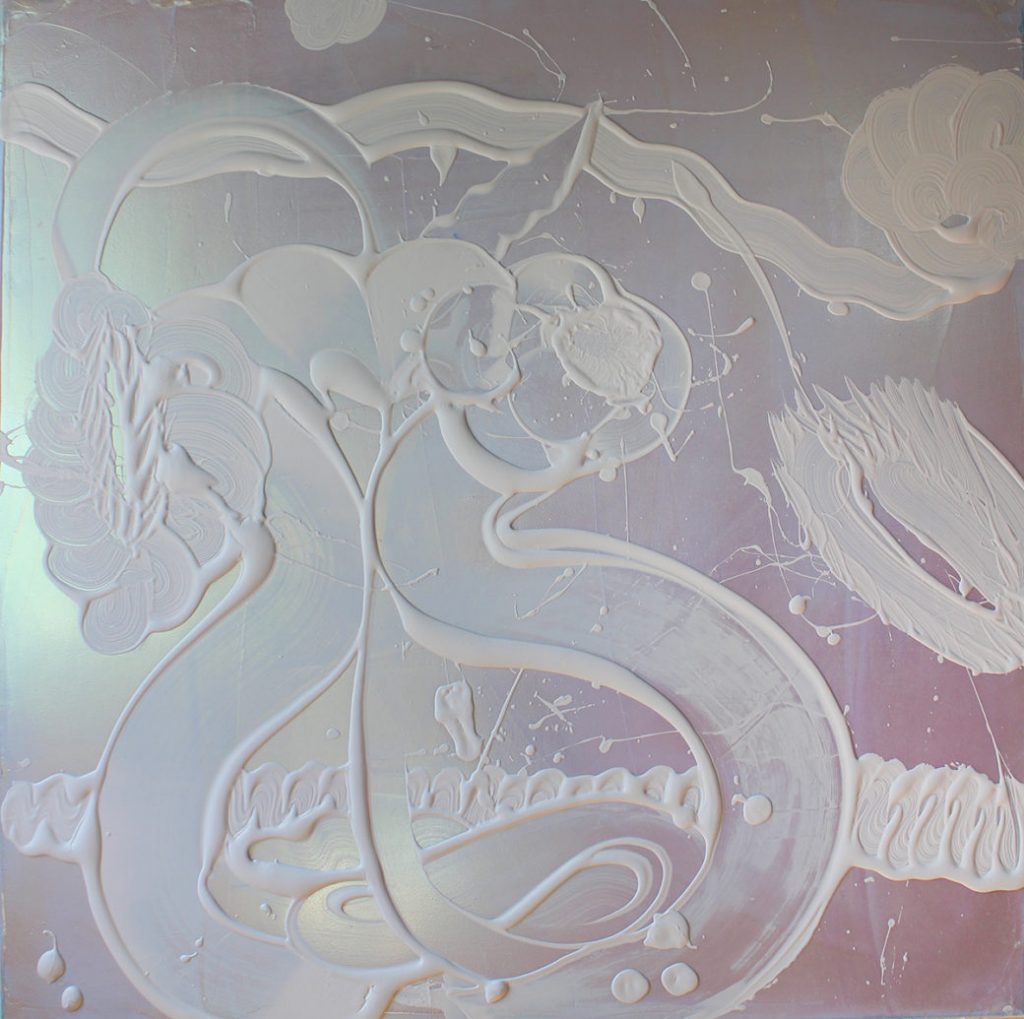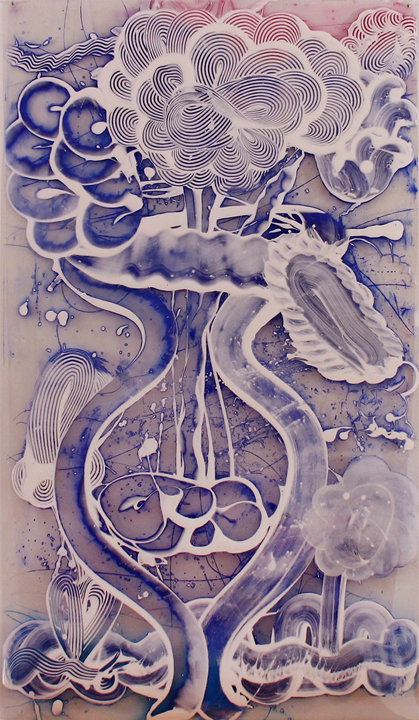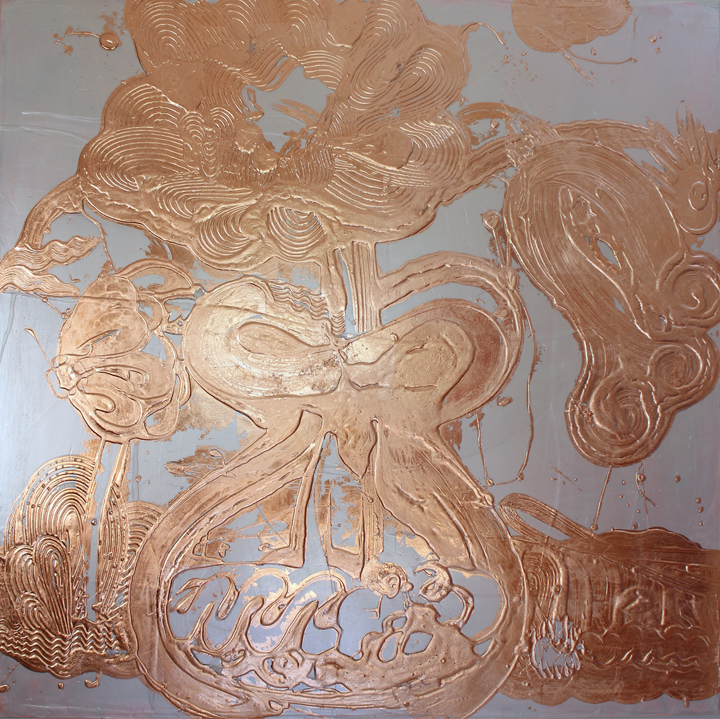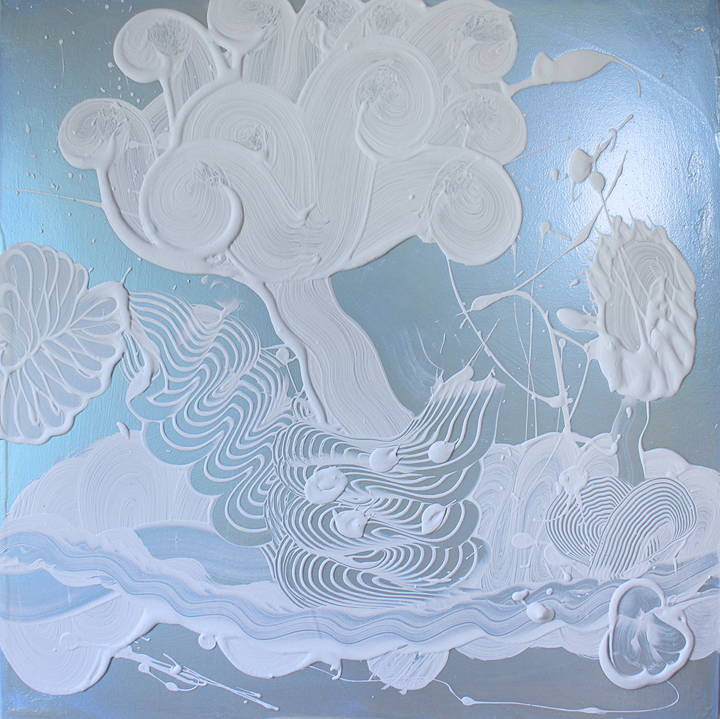
Contributed by Sharon Butler /�Calling Catherine Howe�s whirling, monochromic flower paintings �the pleasure garden� is archly ironic, like calling de Kooning�s early paintings �women.� Although her canvases�outwardly do describe floral forms, their deeper meaning lies in the large, threatening scale, the aggressively fluid use of materials, and the evident physical�energy that went into their making. The paintings might initially appear to be the products of pure agitation.�But, as Dolly Parton has famously quipped, �It costs a lot of money to look this cheap.� Likewise, for a painter, it takes a lot of control to conjure chaos on the canvas and still convey meaning coherently. Howe is a master paint mixer, combining binders, pigments, and metallic additives that she applies to canvas and Mylar with spatulas and other homemade painting tools to create wide, meringue-esque strokes and combed, ribbon-like lines that�lend depth, precision, and nuance to her imagery. The result is a thematically integrated set of beautiful paintings that still never lose their individual distinctiveness.

Like many women these days, Howe seems tired of being ignored. Energized and constructively angry, she has found evocative imagery close to home in the perennial gardens that fill the space between her farmhouse and her studio upstate. When I stopped by last year, the gardens were tidy, as she was deeply engaged in planting and tending them. But one of the hazards of being an artist is the ongoing pressure of time. There is never enough. She told me that eventually, when her attention turns back to the studio, the gardens become overgrown and unruly. Her paintings, in turn, register a kindred confrontation. In their gestural aspect, they are fey and freewheeling, and carry a sense of abandon and joy. Yet the plants depicted are unmistakably distressed, bent and pulverized, some erupting, suggesting that even pastoral refuges can no longer escape corrosion. Topically, climate change might be on her mind. But the overarching concern radiating from Howe�s work is expansively existential: the world faces wholesale disruption, disorder, and risk.

From Sarah Schmerler�s thoughtful catalogue essay, which she compares to the liner notes for a record album, I learned that Howe works on the floor. So prompted, I could see her with her tools in hand, kneeling like a disconsolate Cinderella, her arms moving in wide, arced semicircles from side to side. The intensity, formal unity, and thematic cohesiveness of the paintings give the impression that Howe was on an almost trance-like tear in the studio. I picture her stepping back after a long,�arduous session, catching her breath, shaking herself�back into the world, and walking back to the house for a stiff drink. She returns the next day with a broader perspective, after the pools of swirling metallic paint have dried, and carefully applies silver leaf to the images of gigantic flower heads and stalks. One aim might be simply to visually signify her own agency and control. But I also decipher a more mischievous intent to showcase a knowingly futile attempt to turn what is a visceral outpouring into a politely decorative object: to the great credit of her work, it cannot be done. She is only pretending to try to deceive us.


Don�t expect to fully appreciate Howe�s consummate�virtuosity in jpeg format; the color and its resonance�ought to be experienced IRL. The metallic surfaces continually shift from one hue to another. The big, woozy flowers seem to move from foreground to background depending how the light hits them, and where the viewer stands in relationship to the surface. Howe�s most remarkable achievement may be that she captures the gaslighting that we have endured for the past three years�while also imparting, through the dramatic physicality of her mark–making, how maddening it has been. Pleasure garden indeed. �
Artist�s bio (from the gallery�s website): Howe is a Professor on the Graduate Painting Faculty at the New York Academy of Art, where she leads a seminar on contemporary art. She has exhibited extensively in the United States, including solo exhibitions at Lesley Heller Workspace, Casey Kaplan Gallery, Von Lintel Gallery, the William Shearburn Gallery, and more. Her work has also been included in international exhibitions in Paris, London, Munich, and Amsterdam. She currently lives both in Manhattan and in a farmhouse in the Hudson Valley.
�Catherine Howe; The Pleasure Garden,� Winston W�chter, 530 W. 25th Street, New York, NY. Through October 26, 2019.
�Catherine Howe: Freehand, Monotypes and Mylar Paintings,� curated by Alexi Worth. Platform Project Space, 20 Jay St., DUMBO, Brooklyn, NY. Through October 13, 2019.
Related posts:
Two Coats Selected Gallery Guide: September 2019
Summer studio: Catherine Howe in Clermont, NY
Vintage 1959
Studio Visit (at last) with Lucy Mink

















Wow. I was not familiar with this artist’s work and am blown away. I viscerally respond to”Carborundum and Silver Painting,” and can almost feel the tumult and wind rushing across the space. I also thoroughly relished the depiction of the work. “Energized and constructively angry,” ” Yet the plants depicted are unmistakably distressed, bent and pulverized, some erupting, suggesting that even pastoral refuges can no longer escape corrosion.,”the world faces wholesale disruption, disorder, and risk,” and “But I also decipher a more mischievous intent to showcase a knowingly futile attempt to turn what is a visceral outpouring into a politely decorative object,”…had me responding YES out loud. The work and the essay speak to so much of what I am encountering and expereincing in this tumultuous time, as a woman, and a horrified citizen. Thank you thank you.
Thanks for a terrific review of a transcendent show that, as suggested, readers should see in person if possible. From a distinct point of view, Howe provides a holistic visual gloss on the world–exactly what a painter ought to do.
It is so affirming to have one’s work so thoroughly understood, indeed, expanded and enhanced, by such an insightful writer. Thank you, Sharon Butler.